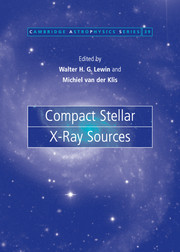Book contents
- Frontmatter
- Contents
- List of contributors
- Preface
- 1 Accreting neutron stars and black holes: a decade of discoveries
- 2 Rapid X-ray variability
- 3 New views of thermonuclear bursts
- 4 Black hole binaries
- 5 Optical, ultraviolet and infrared observations of X-ray binaries
- 6 Fast X-ray transients and X-ray flashes
- 7 Isolated neutron stars
- 8 Globular cluster X-ray sources
- 9 Jets from X-ray binaries
- 10 X-rays from cataclysmic variables
- 11 Super-soft sources
- 12 Compact steller X-ray sources in normal galaxies
- 13 Accretion in compact binaries
- 14 Soft gamma repeaters and anomalous X-ray pulsars: magnetar candidates
- 15 Cosmic gamma-ray bursts, their afterglows, and their host galaxies
- 16 Formation and evolution of compact stellar X-ray sources
- Author index
- Subject index
8 - Globular cluster X-ray sources
Published online by Cambridge University Press: 01 September 2009
- Frontmatter
- Contents
- List of contributors
- Preface
- 1 Accreting neutron stars and black holes: a decade of discoveries
- 2 Rapid X-ray variability
- 3 New views of thermonuclear bursts
- 4 Black hole binaries
- 5 Optical, ultraviolet and infrared observations of X-ray binaries
- 6 Fast X-ray transients and X-ray flashes
- 7 Isolated neutron stars
- 8 Globular cluster X-ray sources
- 9 Jets from X-ray binaries
- 10 X-rays from cataclysmic variables
- 11 Super-soft sources
- 12 Compact steller X-ray sources in normal galaxies
- 13 Accretion in compact binaries
- 14 Soft gamma repeaters and anomalous X-ray pulsars: magnetar candidates
- 15 Cosmic gamma-ray bursts, their afterglows, and their host galaxies
- 16 Formation and evolution of compact stellar X-ray sources
- Author index
- Subject index
Summary
Introduction: some historical remarks
The earliest detections of luminous X-ray sources (LX ≳ 1036 erg s−1) in globular clusters were made with the Uhuru and OSO-7 Observatories (Giacconi et al. 1972, 1974; Clark, Markert & Li, 1975; Canizares & Neighbours, 1975). About 10% of the luminous X-ray sources in our Galaxy are found in globular clusters. This implies that the probability (per unit mass) of finding a luminous X-ray source in a globular cluster is about two to three orders of magnitude higher than of finding one in the rest of our Galaxy (Gursky 1973; Katz 1975). Clearly, the conditions in globular clusters are very special in that they must be very efficient breeding grounds for X-ray binaries. For reviews that reflect the ideas in the late seventies and early eighties, see Lewin (1980), Lewin & Joss (1983), van den Heuvel (1983) and Verbunt & Hut (1987). At that time there was no evidence for a substantial population of binaries in globular clusters; e.g., Gunn and Griffin (1979) did not find a single binary in a spectroscopic search for radial velocity variations of 111 bright stars in M3.
Clark (1975) suggested that the luminous cluster sources are binaries formed by capture from the remnants of massive stars. Fabian, Pringle and Rees (1975) specified that they are formed via tidal capture of neutron stars in close encounters with main-sequence stars. Sutantyo (1975) suggested direct collisions between giants and neutron stars as a formation mechanism.
- Type
- Chapter
- Information
- Compact Stellar X-ray Sources , pp. 341 - 380Publisher: Cambridge University PressPrint publication year: 2006
- 44
- Cited by



